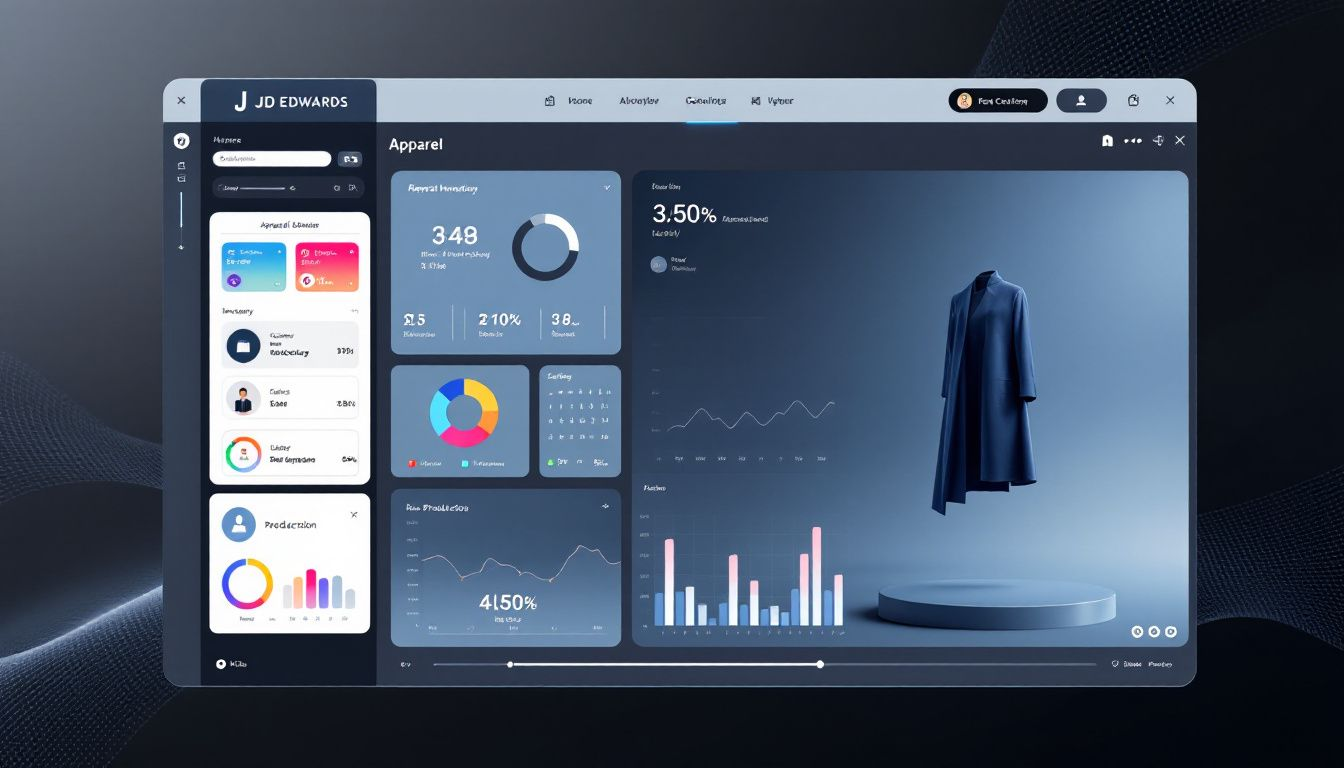JD Edwards Apparel Management is a comprehensive solution designed to meet the unique needs of the fashion and apparel industry. With features like size and color management, style flexibility, and seamless integration with other JD Edwards applications, Apparel Management empowers businesses to optimize efficiency, reduce costs, and deliver exceptional customer experiences.
This article delves into the key capabilities and benefits of the JD Edwards Apparel Management platform for apparel manufacturers and retailers.
Key Takeaways
- JD Edwards Apparel Management streamlines operations by enhancing assortment management and real-time inventory tracking, which is crucial for meeting customer demands.
- The system supports key business processes in both distribution and manufacturing through matrix sales order entries, effective order management, and comprehensive integration across JD Edwards modules.
- Advanced forecasting tools in JD Edwards improve demand planning and inventory alignment, helping apparel companies avoid stockouts and overstocking while enhancing overall business efficiency.
Overview of JD Edwards Apparel Management
JD Edwards, a trusted name in enterprise resource planning, offers a specialized solution for the apparel industry—Oracle JD Edwards Apparel Management. This powerful tool enables the efficient management of articles, bills of materials (BOMs), and production instructions, providing a solid foundation for apparel companies to streamline their operations.
One of the standout features is its ability to make assortment management easier, more transparent, and reliable. Apparel businesses can generate inventory allocation plans to fulfill sales orders on style items, ensuring that the right products are available at the right time. This level of control and visibility is crucial for maintaining smooth operations and meeting customer demands.
With JD Edwards EnterpriseOne, companies in the apparel industry can manage their collections and style items efficiently, ultimately improving their overall business performance. The system’s comprehensive capabilities make it a game-changer for apparel management.
Key Business Processes Supported by JD Edwards

JD Edwards EnterpriseOne Apparel Management is designed to support both distribution and manufacturing sectors within the apparel industry. The system facilitates sales and purchase order entries through a matrix format, simplifying the management of style item information. This feature is particularly beneficial for businesses dealing with a wide range of products and variations, including JDE Apparel Management.
The Sales Order Entry programs (P42101 and P4210) work together to manage sales order records, enhancing efficiency in order management. Coordinating operations across various channels and distribution centers allows businesses to respond swiftly to customer needs and market changes with JD Edwards. Real-time inventory tracking further enhances this capability, allowing companies to maintain optimal inventory levels and minimize the risk of stockouts.
In addition to order management, JD Edwards supports manufacturing capabilities by managing bills of materials and work orders, which are essential for effective production planning. The system also facilitates the effective procurement of materials for manufacturing-style items, whether with or without collections.
Integration with Other JD Edwards Modules
One significant advantage of JD Edwards Apparel Management is its seamless integration with other JD Edwards modules. This integration ensures data flows smoothly across different components, enhancing operational efficiency and decision-making capabilities.
For instance, integration with the Financial Management module enables users to track and manage financial data related to apparel sales efficiently. This integration is crucial for maintaining accurate financial records and making informed business decisions.
Similarly, the Inventory Management module helps define and manage style items, tracking inventory across multiple locations. This real-time visibility into inventory is vital for meeting customer demands and avoiding stockouts.
The Manufacturing Management module integrates with Apparel Management to control production processes and manage work orders for style items. Additionally, Apparel Management connects with Procurement and Subcontract Management to streamline purchasing activities for raw materials.
This comprehensive integration across various JD Edwards ERP modules ensures that apparel and retail companies can manage their critical operations seamlessly and efficiently.
Managing Multi-Attribute Style Items

Managing multi-attribute style items can be complex, but JD Edwards EnterpriseOne Apparel Management simplifies this process through its robust capabilities. The system allows users to manage collections and define multi-attribute style items effectively, ensuring the organized and efficient handling of various product types.
With the ability to forecast style item requirements, JD Edwards helps businesses define multi-attribute style items for better inventory management. Forecasting capabilities help align inventory with market trends and customer demands. The matrix entry feature further simplifies the sales order process by enabling users to input multiple style item attributes simultaneously.
By optimizing the management of multi-attribute items, JD Edwards ensures that production and sales are aligned across the supply chain. This alignment is essential for maintaining operational efficiency and meeting customer expectations in the dynamic apparel industry.
Forecasting and Demand Planning
Forecasting and demand planning are critical components of any successful apparel business. JD Edwards Apparel Management includes advanced tools for effectively anticipating the demand for various style items. These tools help businesses predict demand, ensuring they can meet market expectations and avoid overstocking or stockouts.
The system’s forecasting capabilities allow for managing collections, streamlining demand planning, and aligning inventory with evolving market trends. This alignment is crucial for maintaining a competitive edge in the fast-paced apparel industry. By leveraging advanced forecasting tools, companies can make informed decisions about production, procurement, and inventory management.
JD Edwards provides the necessary tools to facilitate effective forecasting and demand planning, improve responsiveness to changing market demands, and drive sustainable business growth.
Simplifying Order Entry Processes
The order entry process can be a time-consuming and error-prone task, but JD Edwards Apparel Management simplifies it through matrix entry systems and streamlined workflows. These features minimize user input errors and enhance order entry speed, allowing companies to process orders more efficiently.
JD Edwards also enables businesses to effectively manage complex pricing scenarios and intricate product configurations. This capability is particularly beneficial for apparel companies that handle a wide range of products and variations. Effective controls improve profit margins and reduce order entry costs with JD Edwards.
The streamlined order entry processes provided by JD Edwards ensure that apparel companies can manage their orders efficiently, ultimately improving their overall business performance.
Enhancing Supply Chain Visibility
Supply chain visibility is crucial for maintaining operational efficiency and meeting customer demands. JD Edwards Apparel Management enhances this visibility by providing tools for managing inventory allocation and addressing shortages through automated stock management. This ensures efficient inventory utilization for style items, reducing the risk of stockouts and overstocking.
The system also facilitates efficient supply chain execution by ensuring timely delivery of products in optimal condition. By tracking supplier performance, JD Edwards enables businesses to evaluate and enhance relationships based on delivery and quality metrics. This level of visibility and control is essential for maintaining a reliable entire supply chain.
A continuous data flow between JD Edwards modules maintains operational efficiency across supply chain processes. Electronic Data Interchange (EDI) streamlines business document communication, reducing errors and enhancing real-time data exchange. Together, these features enhance supply chain visibility and efficiency.
Key Implementation Steps for JD Edwards Apparel Management

Implementing JD Edwards Apparel Management involves several key steps, including defining the project scope and objectives. This initial step is crucial for setting clear expectations and ensuring the implementation aligns with the company’s business goals.
Configuring user roles and permissions tailored to apparel business processes is necessary when setting up the system. This step ensures users have the appropriate access and capabilities to perform their tasks efficiently.
Data migration is another critical step involving transferring existing apparel data into the JD Edwards system. Proper data migration is essential for maintaining data integrity and ensuring a smooth transition to the new system.
Leveraging Oracle Cloud Infrastructure (OCI)
Moving JD Edwards to Oracle Cloud Infrastructure (OCI) offers numerous benefits, including enhanced security and improved ERP system performance. Scalability with Oracle Cloud solutions enables businesses to easily adjust their resources according to evolving demands.
Flexibility is especially beneficial for apparel companies experiencing seasonal demand fluctuations. Moving to Oracle Cloud offers JD Edwards customers a more secure and scalable environment, enhancing business performance.
Digital Transformation in Apparel Industries
Digital transformation is essential for apparel industries to innovate and improve operational efficiency. JD Edwards supports this transformation by offering robust functionalities that optimize business processes. Hosting JD Edwards systems on Oracle Cloud accelerates digital transformation efforts, providing access to advanced features and reducing maintenance burdens for IT teams.
Integrating JD Edwards with Oracle Cloud Infrastructure enhances scalability and reduces the need for extensive on-premises infrastructure. This integration allows apparel companies to focus on innovation and growth rather than managing IT resources.
Embracing digital transformation helps apparel businesses remain competitive in a rapidly evolving market. JD Edwards provides the tools and capabilities to drive this transformation and achieve sustainable, long-term success.
Get Started with JD Edwards Consultants
From assessing your current JD Edwards system setup and outlining plans for an upgrade or enhancement project to navigating complex integrations and streamlining communication across project teams, Surety Systems can help.
Our senior-level JD Edwards consultants have the skills and experience to handle your critical project needs and ensure your internal teams are prepared for sustainable growth and improvement over time.
Contact Us
For more information about our JD Edwards consulting services or to get started on a project with our team, contact us today.
Frequently Asked Questions
What are the key features of JD Edwards Apparel Management?
JD Edwards Apparel Management offers efficient oversight of articles, BOMs, and production instructions while simplifying assortment management and facilitating inventory allocation plans for style item sales orders.
How does JD Edwards support order management processes?
JD Edwards effectively supports order management processes by streamlining sales and purchase order entries in a matrix format, making it easier to manage style item information. Additionally, it improves operational efficiency by coordinating actions across various channels and distribution centers.
How does JD Edwards enhance supply chain visibility?
JD Edwards enhances supply chain visibility by offering tools for inventory management, supplier performance tracking, and real-time data exchange through EDI, ensuring efficient inventory utilization. This comprehensive approach allows for informed decision-making and operational efficiency.
How does JD Edwards support digital transformation in the apparel industry?
JD Edwards facilitates digital transformation in the apparel industry through its robust functionalities that optimize business processes and by leveraging Oracle Cloud to enhance access to advanced features while reducing IT maintenance burdens. This streamlined approach empowers apparel companies to innovate and adapt efficiently.




